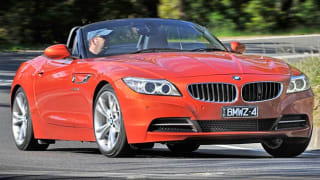
BMW Z4 Coupe 2013 review
BMW Z4 has one of the purest body shapes on the road whether it's used as a closed coupe, or a top-down roadster in which to appreciate the joys of cruising in Australia.
Browse over 9,000 car reviews
The third generation Porsche Boxster, tagged the 981, takes the same styling route as its predecessors, which is no bad thing.
Porsche owners over the years have shown strong resentment to any major changes in direction, so features like the air intakes in front of the rear wheels and the shape of the bonnet and headlights follow a familiar theme.
You can choose between a standard Boxster at a modest starting price for this class of just $107,500, or the high-performance Boxster S with a recommended retail price of $133,800.
The new-generation Porsche Boxster provides a pure-bred machine for what is a very modest price for the class in which it operates. It’s little wonder that dealers are reporting very satisfactory sales in the first few months of this German machine.
The standard variant uses a new-design 2.7-litre flat-six powerplant with direct fuel injection in place of the manifold injection 2.9-litre of the previous model.
Despite its smaller capacity the new unit has 15 per cent more power (now 195 kW), yet uses 13 to 15 per cent less petrol. That’s impressive. Choosing the Porsche Boxster S puts a revised version of the well-established 3.4-litre flat-six just behind your back.
With 232 kW of power and 360 Nm of torque it has higher outputs, but uses less fuel than in the old model. Transmission options are six-speed manual and seven-speed double-clutch PDK automatic.
At the tail there’s more change in the design, with a strong style line that runs the full width, with the taillights following the horizontal shape of the metal.
New Boxster is bigger than before and would have weighed substantially more, but more aluminium has been used than ever before with the bonnet, rear deck and door skins all benefitting from the lightweight material.
Combined with other weight saving measures the mass of the Boxster has trimmed by 25 to 35 kg depending on model. It all helps in improving straight-line performance, providing nimbleness and in reducing emissions and fuel use.
On a slightly more mundane note, there is reasonable stowage space within the Boxster and the fact that it has two boots (one in front the other in the rear) makes it a more than practical long term touring car.
If you’re going to be spending hours each week the PDK makes sense, but if you want to be part of the action it simply doesn’t provide the same sensation of driving as does the ‘proper’ manual gearbox.
On the road the latest Porsche Boxster is close to perfect in its balance and nimble handling. The use of a mid-rear engine, rather than the full-rear unit as in the 911, gives it virtually neutral weight distribution.
The Boxster hangs on to the road at speeds well in excess of those achievable by anything other than an ultra-expensive supercar. And the fact that it’s lighter than the typical supercar makes it more nimble in its feel.
The electrically assisted power steering, which is used to trim fuel use and exhaust emissions, provides better feedback than any similar units we have tested in other cars and really does feel as though your hands are in direct touch with the road.
Depending on the model and options chosen there are various adjustments for the suspension, steering, engine and transmission settings. So Boxster can be tuned to provide a comfortable ride, a firm one or a full on racetrack hardness.
Some sharp potholes and bumps did send a shudder through our test Boxster S on some occasions when we selected the firm Sport setting. Try for yourself during your own pre-purchase test drive to see if the car’s characteristics suit your needs.
The way the Porsche engines sound during gearchanges and on throttle liftoff is simply superb. Even in speed-regulated Australia you can get a lot of pleasure from dropping the roof (it only takes nine seconds and is fully automatic) and just listening to your progress as the powertrain does its sporting best.
The engine has switchable stop-start in the interests of emission reduction. The engine starts almost imperceptibly and we were more than happy to leave it switched on in anything other than very slow traffic crawls.
We have just stepped out of a Boxster S automatic after a most enjoyable week of smile-inducing driving. While we are well aware that the auto is both faster and more economical than the manual our preference is still for the extra driving involvement that’s provided by the manual.
| Vehicle | Specs | Price* | |
|---|---|---|---|
| (base) | 2.7L, PULP, 7 SP AUTO | $34,980 – 41,580 | 2012 Porsche Boxster 2012 (base) Pricing and Specs |
| S | 3.4L, PULP, 6 SP MAN | $41,910 – 49,280 | 2012 Porsche Boxster 2012 S Pricing and Specs |
| Spyder | 3.4L, PULP, 7 SP AUTO | $41,470 – 48,840 | 2012 Porsche Boxster 2012 Spyder Pricing and Specs |
| S Black Edition | 3.4L, PULP, 6 SP MAN | $41,470 – 48,840 | 2012 Porsche Boxster 2012 S Black Edition Pricing and Specs |
$41,910
Lowest price, based on third party pricing data